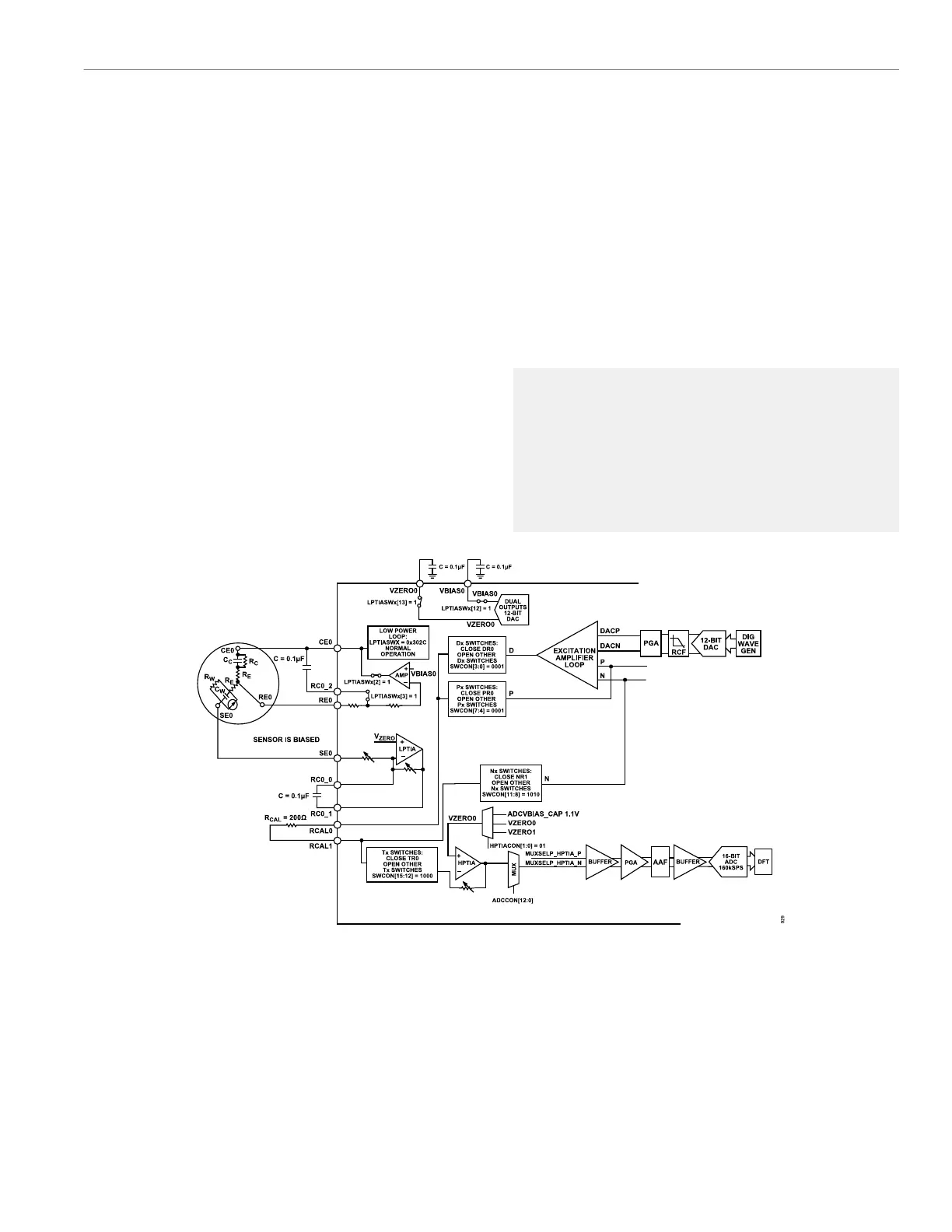Reference Manual ADuCM356
USE CASE CONFIGURATIONS
analog.com Rev. A | 156 of 312
Step 2: Measure R
LOAD02
and External Sensor
(R
SENSOR
)
The electrochemical sensor remains biased during this step, but the
working electrode voltage is set by the high-speed TIA instead of
the low-power TIA.
The R
LOAD02
is a fixed value load resistor (100 Ω). In Figure 41,
the reference electrode is the sensor impedance. The waveform
generator and the high-speed DAC generate a 10 mV amplitude
sine waveform on the DC bias voltage that is required for the
reference electrode and the sensing electrode sensor nodes. DACN
is the bias voltage input to the excitation loop from the high-speed
DAC. The sine wave generated by the high-speed DAC is added
at the DACP node. N, P, DACN, and DACP are four inputs of the
excitation amplifier. The differential voltage between the P node and
the N node is the same as the differential voltage between DACP
and DACN.
The sensor is biased, meaning that the required DC voltage is
applied between the reference electrode and the working electrode.
The AC signal is added to the sensor, and the DC bias voltage
is also maintained. The D node provides the correct voltage and
current. As such, the stimulus sine waveform is added between
the electrochemical sensor reference electrode and the high-speed
TIA input. The reference electrode + R
LOAD02
is included in this
AC excitation loop. At this point, the high-speed TIA output is
measured via the ADC signal chain. The programmed number of
ADC samples are fed to the DFT block, which outputs a complex
number (real or imaginary) that reflects the DFT result for the
ADC measurements of the reference electrode + R
LOAD02
. By using
the RCAL impedance measurement result determined after Step 4
and ratiometric measurements, it is possible to obtain an accurate
reference electrode + R
LOAD02
impedance value.
Configure the Tx, Dx, Nx, and Px switches appropriately, as per the
following example code:
AfeS►
witchDPNT(SWID_D5_CE0,SWID_P5_RE0,SWID_N5_SE0RL
OAD,SWID_T5_SE0RLOAD|SWID_T9);
// Connect Excitation Amplifier D to the LP
// Connect Excitation Amplifier P to RE0
// Connect Excitation Amplifier N to SE0 via
RLOAD02
// Connect HSTIA to SE0 via RLOAD02. Close T9
Figure 41. Step Three of Impedance Measurement, R
LOAD02
+ R
SENSOR
Measurement
Step 3: Measure R
LOAD02
The counter electrode and reference electrode of the electrochem-
ical sensor are floating during this stage of the measurement
sequence.
The main differences between Step 2 and Step 3 are as follows:
► The reference electrode is disconnected from the excitation
amplifier P node.
► The counter electrode is disconnected from the excitation amplifi-
er D node and is connected directly to R
LOAD02
.
► The excitation amplifier D node is connected to the working
electrode node.
Therefore, the excitation signal is applied to R
LOAD02
and the
sensor is floating, as shown in Figure 42. The AC excitation loop D
node, P node, and R
LOAD02
are shorted. The AC excitation loop N
node, TIA T node, and R
LOAD02
are shorted. Measure the stimulus

